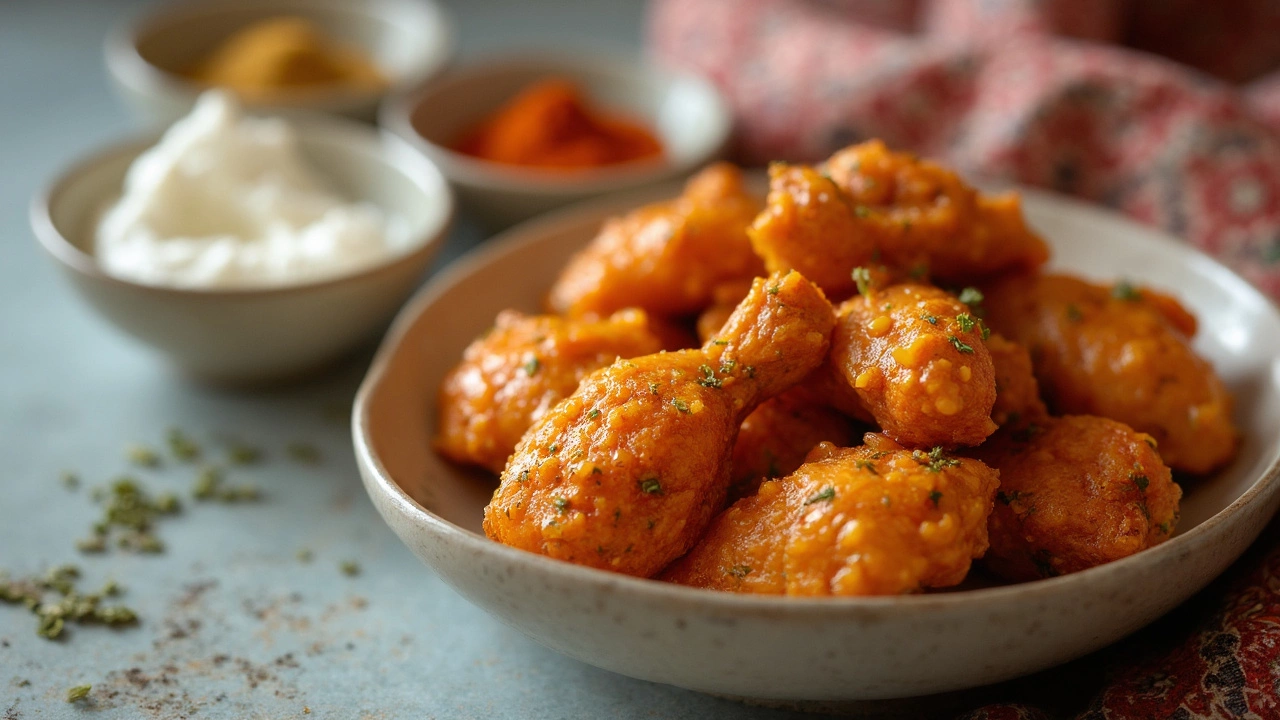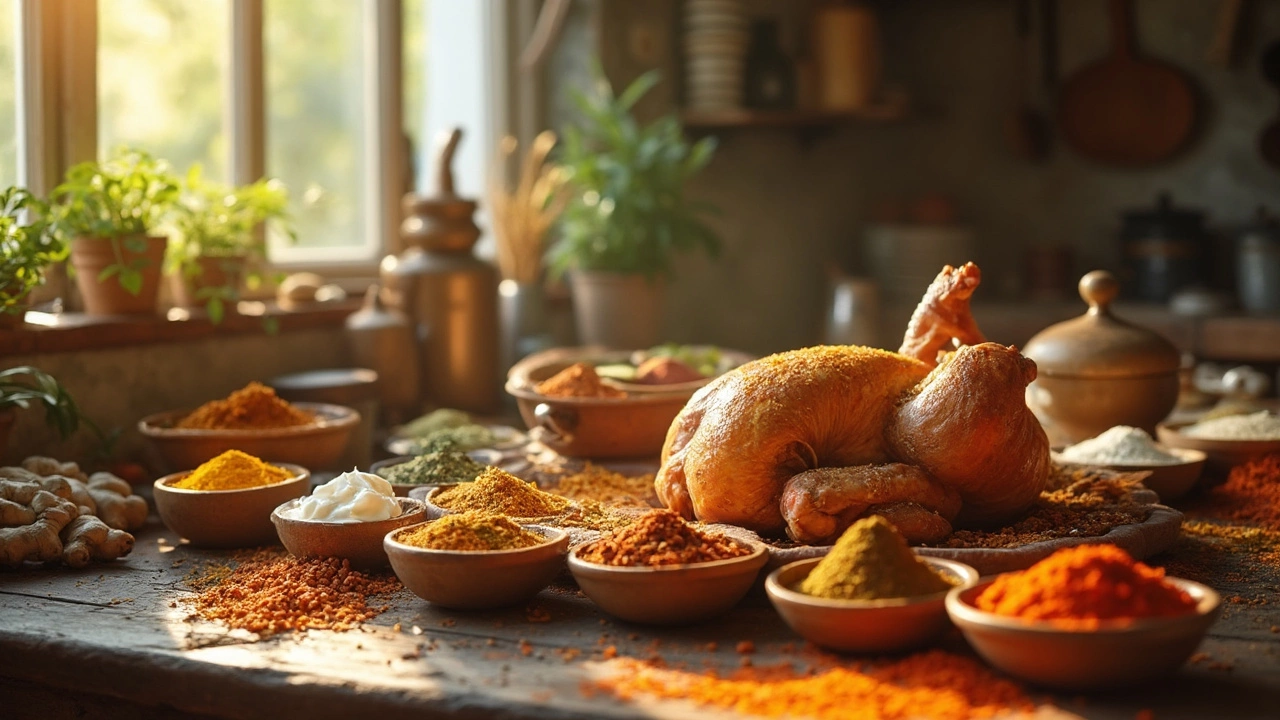If you ever tried to start a tandoori chicken recipe and glanced at your fridge only to find you’re out of Indian yogurt, you’re not alone. This happens more often than you’d think, especially if you don’t shop at an Indian grocery. But no need to scrap your dinner plans—there are some easy swaps for that thick, tangy yogurt that’s usually in the marinade.
Indian yogurt is quite different from regular store-bought yogurt. It’s thicker and has a balanced tang that’s not overpowering. It helps make chicken tender by breaking down proteins, thanks to its lactic acid. If you switch it out, you want something that can still deliver that flavor punch and tenderizing power. Some options work better than others, and your choice can totally change how your tandoori chicken tastes and feels—so it’s worth knowing your way around the fridge.
- Why Yogurt Matters in Tandoori Chicken
- Top Substitutes for Indian Yogurt
- How Each Substitute Impacts Flavor and Texture
- Getting the Marinade Right with Your Substitute
- Quick Fixes and Creative Tips
Why Yogurt Matters in Tandoori Chicken
Indian yogurt isn't just a random ingredient tossed into tandoori chicken—it's actually the backbone of the marinade. The way yogurt works its magic is pretty simple: it has lactic acid. This acid breaks down tough chicken fibers, making the meat tender and juicy after it cooks.
Think about the classic tandoori chicken texture. It's moist, never rubbery, and loaded with flavor in every bite. A huge part of that is because of yogurt. It coats the chicken so all the spices stick, and thanks to its thick texture, it holds on tight during marinating. Regular marinades just slip right off, but yogurt acts like a flavor glue.
Another big reason people use yogurt in tandoori chicken is the taste. Indian yogurt, also called dahi, is creamy and a bit tangy but never super sour. That tang cuts through the bold spices like cumin, coriander, and chili powder, balancing the flavors instead of overpowering your tongue.
- Tenderizing: Yogurt makes the chicken soft by breaking down proteins without turning it mushy like some acidic marinades might.
- Flavor protection: Yogurt helps the spices stick and get deep into the chicken, so every bite tastes just right.
- Milder tang: Compared to lemon juice or vinegar, yogurt's acidity is gentle, which means your tandoori chicken stays nicely balanced.
| Marinade Ingredient | Main Role |
|---|---|
| Indian Yogurt | Tenderizing, flavor balance |
| Lemon Juice | Tenderizing, adds sharp tang |
| Buttermilk | Tenderizing, less thick, subtle tang |
Without the yogurt or a good substitute, you're risking dry, bland chicken. That's why picking the right Indian yogurt substitute makes such a difference. Next, it's time to see what you can swap in if you run out of the real stuff.
Top Substitutes for Indian Yogurt
So, what can actually stand in for Indian yogurt if you're making tandoori chicken? Let’s break down the real-world choices. Some are probably already sitting in your fridge. Each of these brings its own flavor or texture twist, but all can get the job done if used right.
- Greek Yogurt: This is the closest match you’ll easily find. It’s thick, creamy, and tangy but a bit less sour than Indian dahi. Go for the plain, full-fat Greek yogurt for the juiciest chicken and the richest flavor. If you can only get low-fat Greek, that’s fine too, as long as it’s unsweetened.
- Plain Regular Yogurt: Not as thick, but totally useable. If your regular yogurt is runny, just strain it using a cheesecloth or even a fine mesh strainer for 10–15 minutes. That takes out excess water and gives you a better marinade.
- Sour Cream: Sour cream is tangier and richer than Indian yogurt. The fat helps keep the chicken moist, although the sourness can be a bit sharp. If it’s too thick, thin it out with a tablespoon of milk or a squeeze of lemon juice mixed in.
- Non-Dairy Yogurts: If you’re dairy-free, coconut or soy-based yogurt works too. Just make sure to pick unsweetened and plain flavors—nobody wants vanilla coconut tandoori. Coconut yogurt does leave a faint coconut aftertaste, so keep that in mind for your spices.
- Buttermilk: This one’s a bit runny, but the tang is on point. If you use buttermilk, cut back the quantity a little and add one to two tablespoons of either chickpea flour or gram flour to thicken it for marinating.
Here’s a quick cheat sheet for a fast look at how these substitutes stack up against traditional Indian yogurt:
| Substitute | Texture | Tanginess | Best for |
|---|---|---|---|
| Greek Yogurt | Thick, creamy | Medium | Most authentic dupe |
| Regular Yogurt (strained) | Medium | Low-medium | Easy fix |
| Sour Cream | Very thick | High | Extra tender/juicy |
| Non-Dairy Yogurt | Varies | Usually low | Dairy-free option |
| Buttermilk + Gram Flour | Thin, needs thickening | Medium-high | Imparts tang |
Whatever substitute you pick, aim for unsweetened and as plain as possible. This lets the tandoori spices do their thing and keeps your marinade spot-on.

How Each Substitute Impacts Flavor and Texture
Switching out Indian yogurt in your tandoori chicken recipe isn’t as simple as grabbing any dairy product from the fridge. Each substitute acts differently when it comes to taste and how tender your chicken gets. Here’s what you can expect from the popular swaps:
- Greek yogurt: This is hands down the closest match. It’s thick, tangy, and holds onto the spices just like Indian yogurt does. It gives you the same rich, creamy marinade and keeps the chicken moist. If you want the most authentic flavor in your tandoori chicken, this is your go-to. Just avoid the “zero fat” kind—the full-fat Greek style makes all the difference for flavor and texture.
- Sour cream: Super tangy, slightly less creamy. Sour cream will give your chicken a sharper bite, but it doesn’t break down the meat quite as well. You’ll get decent tenderness, especially if you let it marinate overnight, but your chicken might end up a little heavier than with yogurt.
- Buttermilk: This one is thinner, so the marinade won’t cling as well. Buttermilk is more acidic than yogurt, which does wonders for tenderizing. Just be ready for a subtler tang and a slightly thinner coating. A tip: Add a tablespoon of oil or a spoonful of ground nuts to thicken it up if needed.
- Non-dairy yogurts (like coconut or almond): If you want something dairy-free, pick plain, unsweetened versions. Coconut yogurt brings a little sweetness, but it’s usually mellow enough not to mess with your spice mix. The main downside is that some brands can be runny—choose the thickest option for the best marinade stickiness.
- Labneh: If you happen to have labneh, it’s even thicker than Greek yogurt. It brings richness and tang but might overpower the spices if you use too much. Thin it with a bit of milk or water first so it doesn’t mask the rest of your marinade.
If you’re curious about how these swaps really compare, check out this quick table showing how key substitutes stack up in terms of tanginess and how well they tenderize chicken:
| Substitute | Tanginess | Texture | Tenderizing Power |
|---|---|---|---|
| Greek Yogurt | Medium | Thick & Creamy | High |
| Sour Cream | High | Medium | Medium |
| Buttermilk | Medium-High | Thin | High |
| Non-dairy Yogurt | Low-Medium | Varies | Medium |
| Labneh | High | Very Thick | High |
The bottom line? Greek yogurt keeps you closest to the real deal, but don’t be afraid to experiment if you’re in a bind. Just adjust the spice and liquid levels if things look too thick or too runny.
Getting the Marinade Right with Your Substitute
So, you’ve picked a yogurt alternative for tandoori chicken, but now you’re wondering if it needs any tweaking. The answer is yes—swapping Indian yogurt for something else might change the way your marinade acts. It’s not just about flavor; texture and the way the chicken turns out can vary a lot.
First up, stick to the same amount as your original recipe calls for. Using a thicker Greek yogurt substitute? You may want to add a splash of water or lemon juice to loosen it up. If you’ve chosen a non-dairy yogurt (like coconut or almond), taste it before you mix it in. Some brands are a touch sweet, so you might need to counter that with an extra pinch of salt or a dash of lemon.
Mixing your marinade is all about balance. Here’s a quick step-by-step if you’re using an alternative:
- Add your substitute into a large mixing bowl.
- Whisk in all your spices—garam masala, chili powder, cumin, and turmeric. Don’t hold back here; alternative yogurts can sometimes mute flavors, so go bold.
- If your yogurt is on the blander or thicker side, add 1-2 teaspoons of lemon juice or vinegar to give it that Indian yogurt substitute tang.
- Add a splash of oil if your non-dairy yogurt is very low-fat. A little fat helps the chicken stay juicy.
- Drop the chicken pieces in, making sure every piece is well coated.
Timing matters too. Let your chicken sit in the marinade for at least 4 hours—overnight is even better. This gives your substitute time to work its magic, breaking down chicken fibers and soaking up all that spice.
Not sure how your substitute compares? Here’s a quick reference for popular options:
| Substitute | Tanginess | Texture | Best For |
|---|---|---|---|
| Greek Yogurt | Moderate | Very thick | Classic tandoori texture, easy to adjust |
| Plain Yogurt | Mild | Runny | Needs straining; add lemon juice for tang |
| Coconut Yogurt (unsweetened) | Mild | Creamy | Vegan/Non-dairy; add extra spices |
| Almond Yogurt | Light | Thin | Works in a pinch; boost with lemon |
| Sour Cream (full-fat) | Strong | Thick | Great for richness; skip lemon |
If everything tastes right, don’t worry if the marinade looks a little different from what you’re used to. The chicken will still cook up juicy and packed with flavor. Just remember to crank up the heat at the end or broil for charred edges—because that’s what everyone really loves about tandoori chicken.

Quick Fixes and Creative Tips
When you don’t have Indian yogurt and need a speedy fix for your tandoori chicken marinade, don’t panic. There are some smart shortcuts and tweaks that work in a pinch, so you won’t be left with dry and bland chicken.
- Greek Yogurt: This is the most reliable stand-in for Indian yogurt substitute. If it’s too thick, loosen it with a tablespoon or two of milk. Check the label to avoid sweetened versions that will ruin your marinade.
- Sour Cream: Go for the full-fat version. It’s tangy and rich, and mixes well with spices. Just don’t go overboard—use a little less than you would yogurt, as it’s heavier.
- Buttermilk: Not as thick, but quite tangy. If you use it, marinate your chicken a little longer—maybe 6-8 hours. It’s better for a milder flavor, and perfect if you like your chicken really juicy.
- Dairy-Free Alternatives: Coconut yogurt or cashew yogurt work okay if you’re cutting out dairy. Pick unsweetened, plain versions. You might want to add a squeeze of lemon juice for extra tang.
- Lemon Juice and Cream Cheese: This sounds odd but mix a tablespoon of lemon juice into cream cheese to mimic the sharpness and thickness of Indian yogurt. It’s good for small batches or if you’re running seriously low on supplies.
Getting the flavor right with substitutes means you may need minor adjustments. Taste your marinade before adding the chicken—if it’s not tangy enough, add more lemon juice or a splash of vinegar. For thickness, stir in a spoonful of cornstarch or chickpea flour.
Here’s a cheat-sheet comparing how well these substitutes stack up for marinade tips:
| Substitute | Tanginess | Texture | Best for |
|---|---|---|---|
| Greek Yogurt | Moderate | Thick/creamy | Standard marinades |
| Sour Cream | Sharp | Very thick | Extra-rich coating |
| Buttermilk | Strong | Runny | Juicy chicken |
| Coconut Yogurt | Mild | Creamy | Dairy-free option |
| Cream Cheese + Lemon | Sharp | Very thick | Small batches |
If your marinade has gotten too runny, don’t just add more yogurt—it can mess with the spice balance. Instead, use a little gram flour (besan) or all-purpose flour to thicken it up fast. And when you’re baking or grilling, spritz the chicken with oil so it stays moist—whatever substitute you’re using.
At the end of the day, tandoori chicken is pretty forgiving. A good substitute for Indian yogurt is all about balancing tang and creaminess. If you know how these swaps act, you can whip up something tasty with what you have at home.
